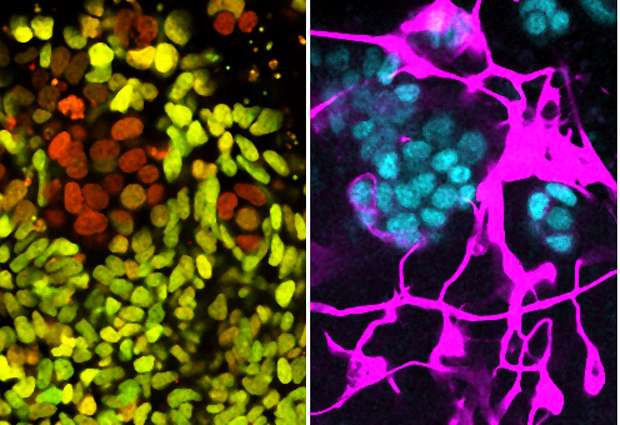Forever young—how stem cells resist change

This 'before and after' image could be thought of as stem cells' equivalent of an advert for anti-wrinkle cream: 'look how cells stay young!' It shows that a molecule called microRNA-142 allows stem cells to remain unchanged, instead of growing into specialised cell types. Given the right conditions, stem cells with low levels of microRNA-142 (green, left) grow into neurons (pink, right). But stem cells with high levels of the molecule (red, left) remain unchanged (blue, right), scientists at EMBL in Heidelberg, Germany, have found.
"It seems that this microRNA leaves the cells deaf to their environment: you can 'throw' whatever you want at them, and they don't care: they carry on being stem cells," says Pierre Neveu, who led the work.
The finding, published in Molecular Systems Biology in December, could have implications for cancer treatment and regenerative medicine, as well as more fundamental research. Hanna Sladitschek, a PhD student in Neveu's lab, found that this microRNA suppresses a gene that can turn cells into tumour cells. And it blocks two chain reactions that have also been linked to cancer. "So you could think of delivering the microRNA to cells to prevent tumours from spreading," Neveu postulates.
For colleagues working in regenerative medicine, the knowledge could bring increased safety and efficiency. If researchers growing tissue from stem cells in the lab removed cells with high levels of miRNA-142, they would reduce the risk that the tissue they implant back into patients still contains stem cells, which can develop into tumours. And selecting which cells to keep based on their levels of miRNA-142 could also considerably shorten the time needed to grow such tissues.
More information: H. L. Sladitschek et al. The bimodally expressed microRNA miR-142 gates exit from pluripotency, Molecular Systems Biology (2015). DOI: 10.15252/msb.20156525
Journal information: Molecular Systems Biology
Provided by European Molecular Biology Laboratory





















